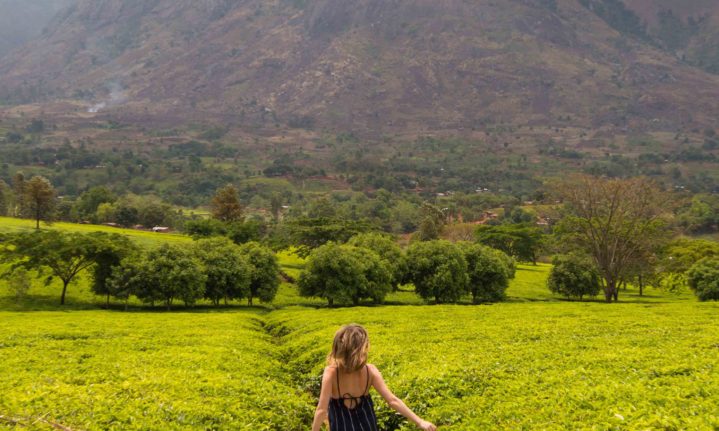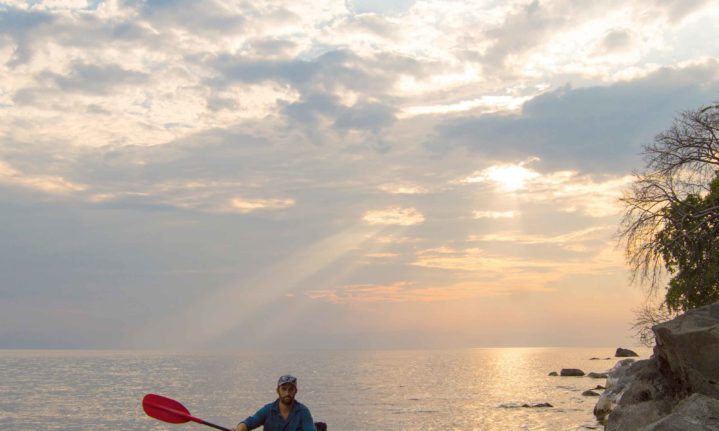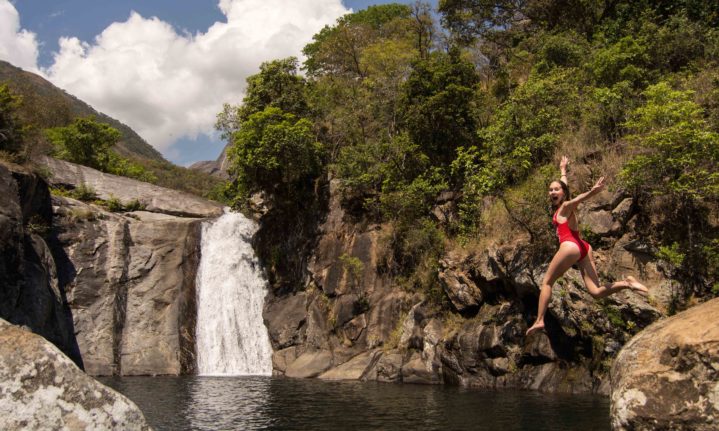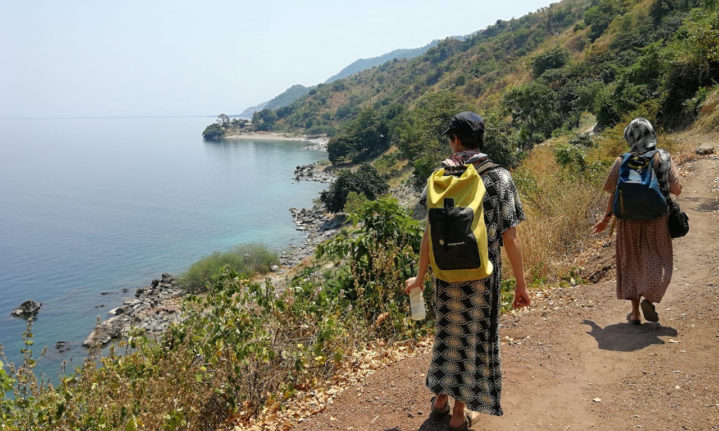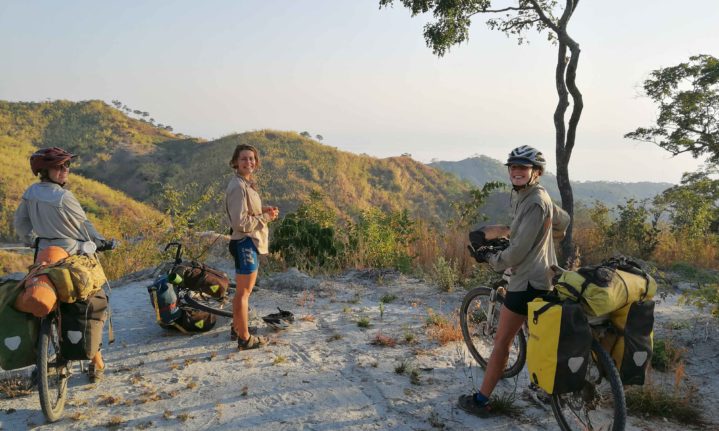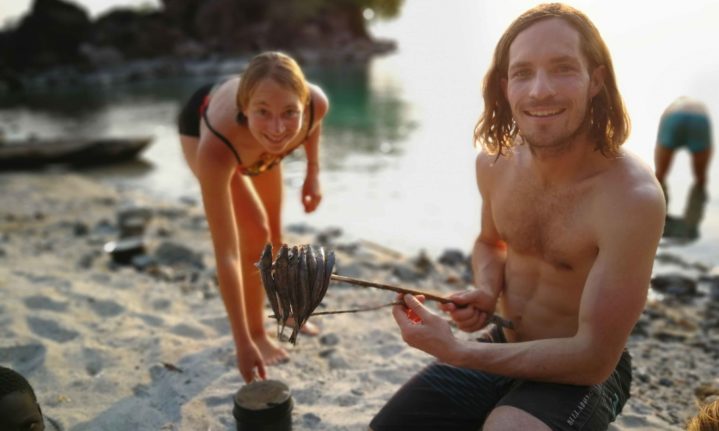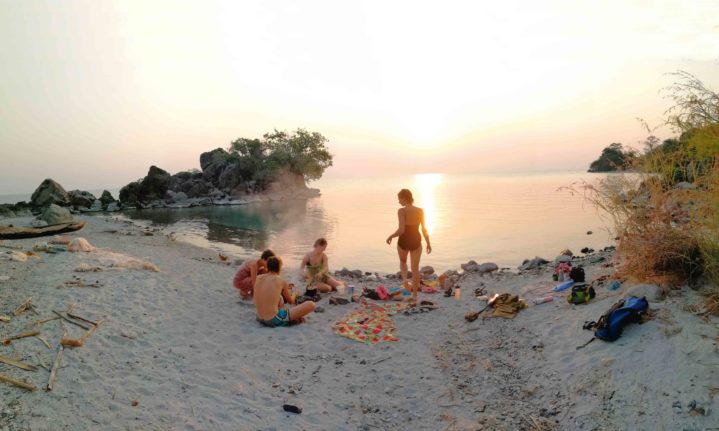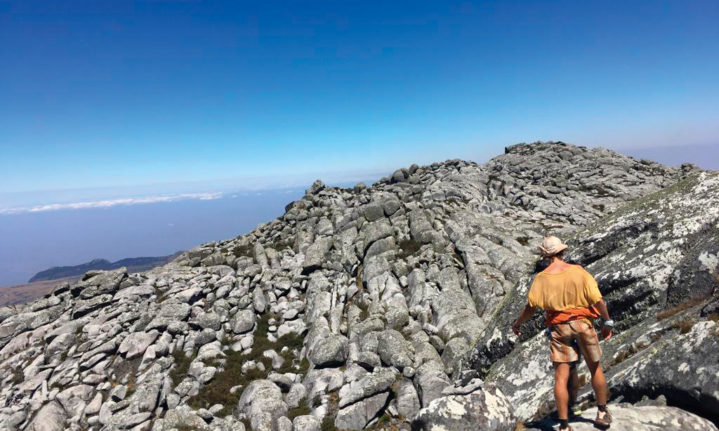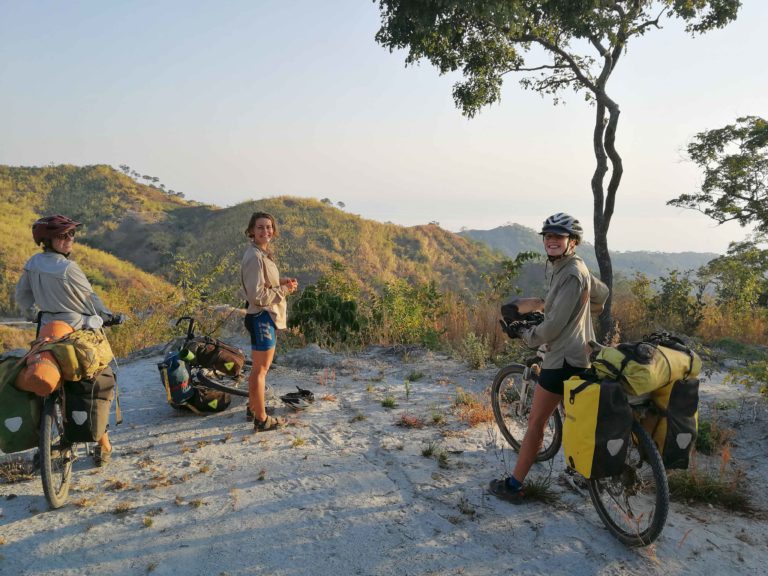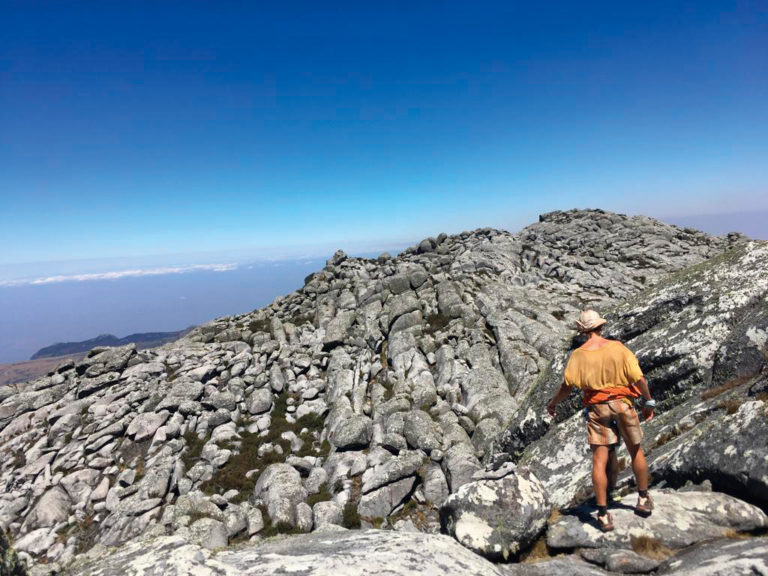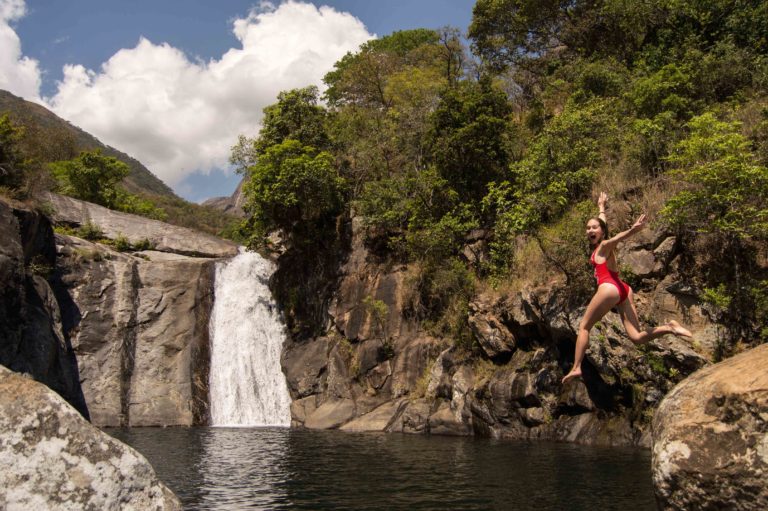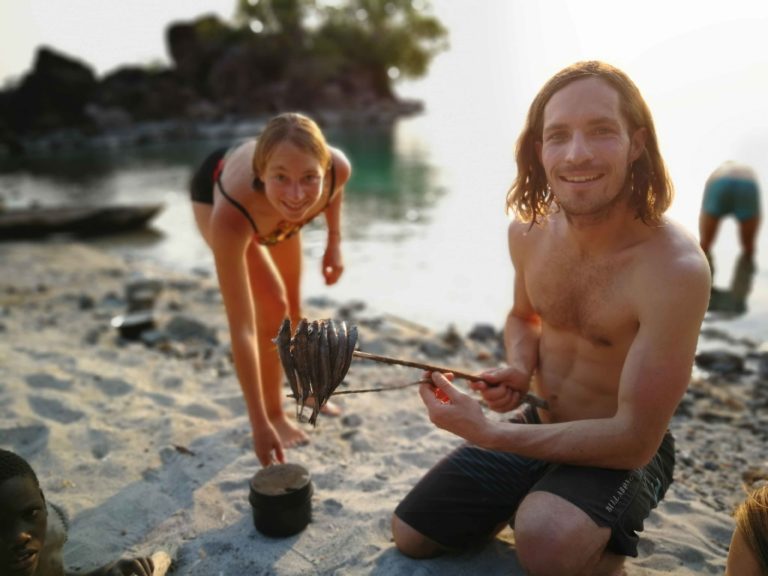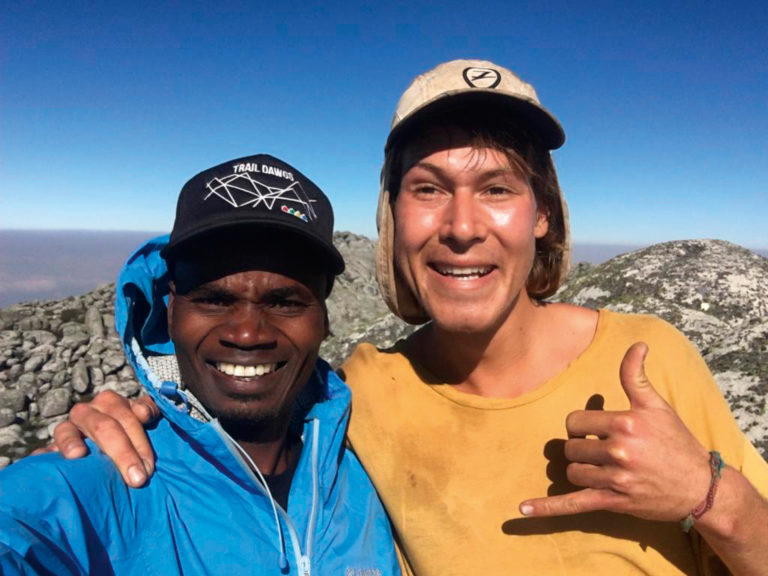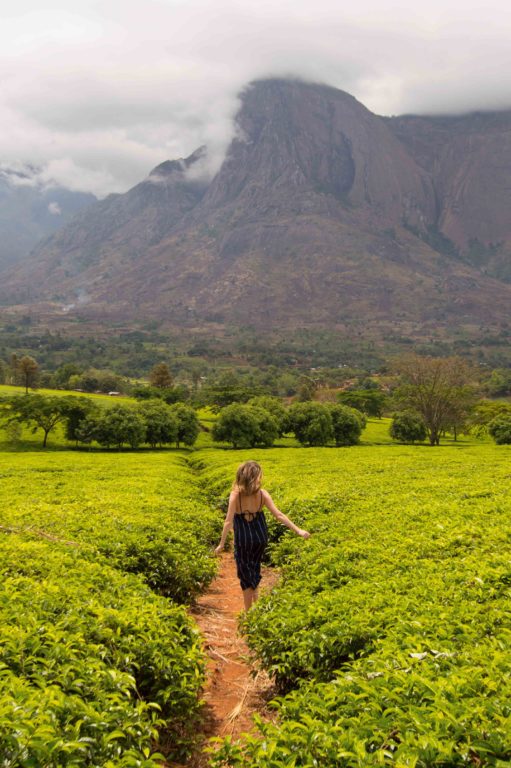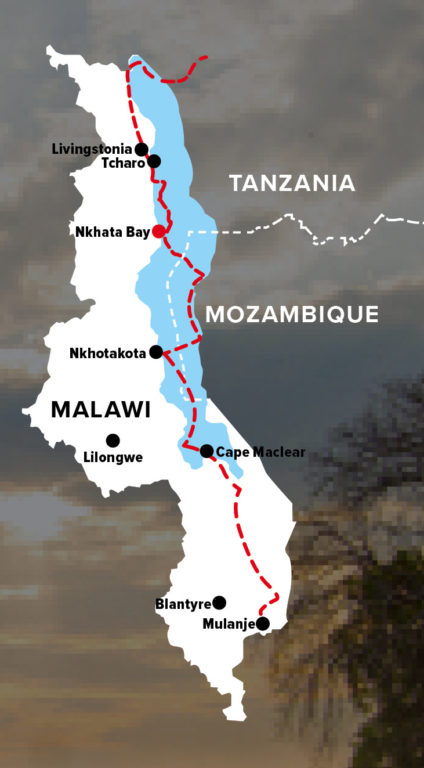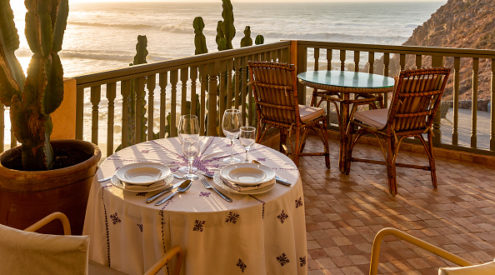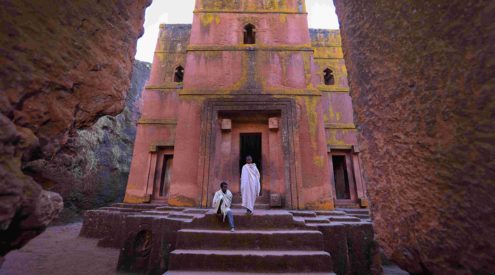It’s highly unusual to enter Malawi from the northern lakeshore mountains, doubly so on a bicycle. But this just upped the adventure on a trip through the Warm Heart of Africa by bike, boat and backpack.
Words by Lauren Granger
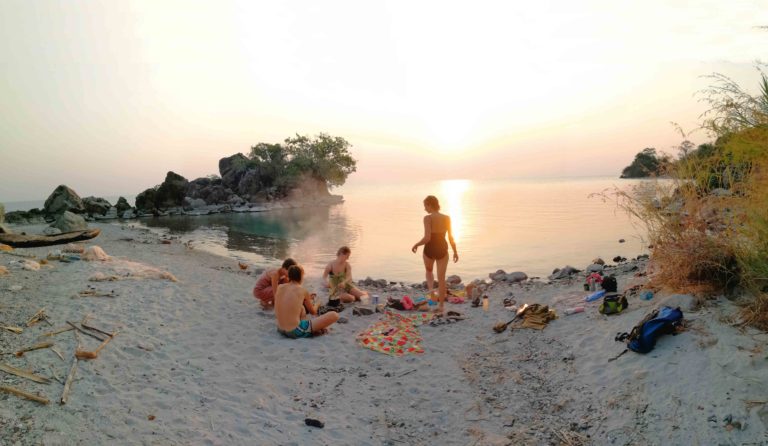
We shared a paradisiacal cove with carved wooden bwatos and fishing nets, on the remote north-western shores of Lake Malawi. Image: Devin Dollery.
‘Do you want the good news or the bad news?’ Still half asleep, we didn’t get the chance to pick before Devin delivered both. ‘Bad news, we don’t seem to be anywhere that is anywhere. Good news, about 200 metres from here there’s a two-foot wave, perfect for body- surfing!’ I flicked off the sleeping bag and sat up. Suz and I had managed to snooze through the usually effective alarm clock of brightness and heat that comes with the first glimpse of the African sun, now well clear of the horizon.
I looked about, taking in our surroundings, which had been hidden during our boat arrival in the dark the previous night. We were on a beach of pristine white sand, our beds a few metres from the lake which stretched on forever, one brilliant glare of shimmering gold. The green mountains rose steeply behind us and fell away sharply to our left and right, straight into deep water. At first glance I saw no houses, no people, no boats. It wasn’t ‘anywhere that is anywhere’. And that was the bad news. I couldn’t help but smile.
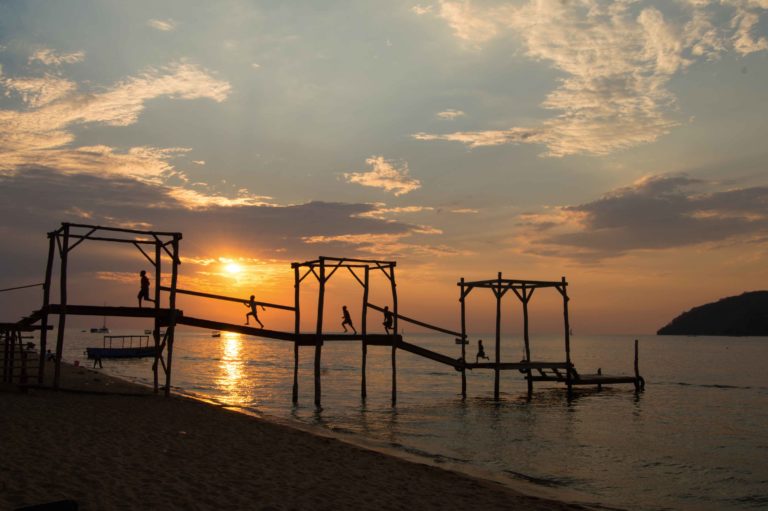
Cape Maclear is a sublime play- ground for local children and tourists alike – Kayak Africa’s jetty with Thumbi West Island behind.
A week before, we’d crossed into Malawi on bicycles, via the Livingstone Mountains of southern Tanzania, where we caught our first glimpse of the ‘Lake of Stars’, as it’s known, taken some 1,000 metres up. Our preloaded cellular maps had failed to fully disclose the topography of our route, creating the impression that is was mostly downhill. The unrelenting ups kept punctuating the anticipated downs, and then we saw it – one final nerve-wrackingly steep descent lead us to the lake shore and the start of our Malawian adventure.
We were a group of five South Africans, traversing Malawi as part of a year-long cycling adventure that had started for some in Cairo seven months before. Our plan for Malawi was to explore the mountainous north-west, then make our way by boat to the annual Lake of Stars music festival, before heading south-east to swap our bicycles for backpacks on the trails of Mount Mulanje.
We reached a point when sticking to the north-western lakeshore was no longer bicycle friendly. The spectacular cliff paths that link up the scattering of villages must be among the most incredible hiking trails in all the world, but were not viable for our heavily-laden bicycles. No problem, there is always a plan to be made in Malawi. Local fishermen helped us load the bikes into a small wooden boat, explaining that it would take us to the village of Tcharo where the MV Ilala, Malawi’s iconic ferry, stops in.
Things didn’t go exactly as planned – five hours into the two-hour boat trip, day had turned to night and we were riding large wind swells on a glittering lake, the magic of the experience outweighing our apprehension. These very swells, brought by the Mwera (strong south-easterly winds), were the reason we woke up in a spot that wasn’t ‘anywhere that is anywhere’, having been offloaded in a sheltered bay two kilometres short of Tcharo. For us the swells also meant bodysurfing!
After dreamy days spent hiking, canoeing, beaching and eating fresh fish with the local staple, cassava nsima (pap made from dried cassava rather than maize), we all agreed that it’s overrated when things go according to plan – and often better when they don’t. Cassava nsima is, perhaps, the only aspect of our northern Malawian experience that I wouldn’t wholeheartedly recommend.
The MV Ilala is a noteworthy adventure in her own right. Plying the lake since 1951, from Monkey Bay in the south to Chilumba in the north and back, she’s a trusty, weekly mode of transport for everything from bicycles to livestock and tropical fish. We splashed out on first-class tickets. This allowed us to roam (and sleep on) the top wooden deck, which boasts a quaint bar serving beer at 5am, should you want it, as we discovered most passengers do. Scenic and peaceful while chugging along the lake, we were unprepared for the chaos at each stop, caused not only by passengers embarking and disembarking, but also a rush to the onboard bar. In the rural lakeside villages cold beer is only available once a week, for an hour or so, while the MV Ilala anchors in the bay.
We broke our ferry journey south in Nkhata Bay to attend the internationally renowned Lake of Stars music festival, which, until this year, took place at a different lakeside location each year. And, of course, to enjoy one of Malawi’s greatest gems – Malawi Gin. Deceptively cheap, it’s incredible stuff, guaranteed to make any gin snob smile (unfortunately, tonic was an elusive luxury).
‘If you go to Malawi, you have to go to Cape Maclear.’ This was the advice given by anyone we asked, and the same advice I’ll pass on. At the southern end of the lake we enjoyed all the natural wonders that put Cape Maclear, or Chembe village, on the map; hiking in Lake Malawi National Park, superb snorkelling and kayaking in crystal-blue waters and around uninhabited islands, where, I’m fairly certain fish eagles grow on the trees. Cape Maclear also boasts tourist comforts including a wide range of accommodation, restaurants and tonic to go with your Malawi Gin. But none of this has changed the character of the place, which remains a quintessentially Lake Malawian village.
After our off-road adventures in the north, we were more than happy to cycle along the newly tarred highways south of Cape Maclear – yes, the highways. These make for mellow cycling as most road users also commute by bicycle. What a joy it was to ride five abreast on the M3 – only breaking our social formation for the odd passing car – all the way down to the tea plantations of Mulanje.
We met Edson Kumwamba on the soccer field of his old high school, Mount Mulanje forming an impressive backdrop in the light of the dipping sun. A friend from the Cape Town trail-running scene, Edson had recently moved back here, to the place he calls home. What an honour it was that he would lead us for three days and two nights up there in the clouds.
Edson first climbed Mount Mulanje when he was nine years old. ‘I went to watch the annual Porters’ Race with my mother. I knew that the winner got a Coke, and I wanted a Coke so I asked her if I could follow the runners. I ended up running the whole way, all 22 kilometres!’ He told us the story as we hiked the steep trail that the Porters’ Race follows, out of Likhubula village and up to what is known as ‘The Top’. Here, where great peaks tower above the green plateau, invisible from the village below, I understood why Mount Mulanje is known as ‘The Island in the Sky’. There was just no better way to describe where we stood.
Eighteen routes and 10 huts dotted across the ‘Island’ meant that our options for multiday hikes were endless. We stayed at Chambe and Chisepo huts, and both were equipped with all the mountain-hut necessities – breathtaking views, cold streams to freshen up in, mattresses, firewood and even beer. In the morning we summited the highest of the peaks, Sapitwe, which means ‘a place you should not go’. Edson had assured us that if we kept the ancestors happy we ought to be okay (it’s important to have a local guide to explain all this).

Lauren Granger and Suz Lambert wander from one pristine beach to another along the cliffs of the northern lakeshore.
Edson laughed when I asked if he ever got his Coke. ‘No, I took six hours to finish, it was dark and everyone had gone home.’
On our descent we rested at the Likhubula Waterfall. We asked the ancestors’ permission before diving into the deep pool at its base. I also took the opportunity to whisper my thanks, not just for the cool, cleansing dip, but for everything we’d experienced from the Lake of Stars to the Island in the Sky.

Go on a kayaking hunt for colourful cichlids and fish eagles round the islands of Lake Malawi National Park off Cape Maclear.
Plan your trip
How to get there
Return flights from Johannesburg to Lilongwe start at around R8,000 with Ethiopian Airlines. ethiopianairlines.com
When to go
Year round, but avoid the hot summer rainfall season from November to April. Originally only for Mulanje’s porters, the Porters’ Race now attracts hundreds of participants from all over the world. The date for the 2020 Porters’ Race is still unconfirmed, but it’s usually the second weekend of July.
Need to know
Certain parts of Malawi are malaria areas – consult your doctor about prophylactics.
Our cycle through Malawi was self-navigated and self-supported which, from our experience, is a fun, easy, cheap and safe way to do it. Don’t be afraid to wing it a bit, but set yourself up with proper panniers, not a backpack. Grant at cycletouring.co.za is incredibly knowledgeable and helped kit me out with all the essentials. Alternatively, there are several operators offering tailored bicycle tours in Malawi. Try Cycle Malawi, cyclemalawi.org.
Stay here
NORTHERN MALAWI
The Mushroom Farm, near Livingstonia, is high above the lakeshore with a view of the Great Rift Valley and lake below. Simple, comfortable and off the grid, this eco-lodge serves superb local food, made from fresh organic produce grown in it’s garden. Camping from R70 pp, with dorms and private cabins too. Make sure you take the short stroll to the Manchewe Falls. themushroomfarmmalawi.com
NKHATA BAY
Butterfly Space is a lovely eco-lodge and volunteering project on a cliff overlooking the lake, with its own beach. Camping from R60 pp, rooms from R135 pp. butterflyspacemalawi.com
CAPE MACLEAR
Various options include camping, bar and meals right on the lake at Fat Monkeys from R120 pp. fatmonkeysmw.com
MULANJE
Spend a night in one of the mountain huts. You can’t book these in advance (but mountain rules apply and no one is turned away). R20 pp payable at the park entrance gate to the Likhubula Trail.
Rest up before and after your hike at AfricaWildTruck Camp and Lodge, from R750 pp, B&B. africawildtruck.com
Do this
Ride the MV Ilala ferry. Schedules and fares at malawitourism.com.
Kayak/snorkel Cape Maclear
An overnight kayak trip to either Domwe or Mumbo islands is a must. Kayak Africa offer packages starting from R450 pp. It also offers cycling/kayaking combination trips. kayakafrica.co.za
Hike Mount Mulanje. You need to be hiking fit to reach ‘The Island’ but from there hikes vary in length and difficulty. Chambe is a three- to four- hour hike on the Likhubula trails. The Likhubula Waterfall is an easy morning’s walk. Find a local guide (essential) on TripAdvisor. tripadvisor.com
This article was first published in the April 2020 issue of Getaway magazine.
Get this issue →
All prices correct at publication, but are subject to change at each establishment’s discretion. Please check with them before booking or buying.










